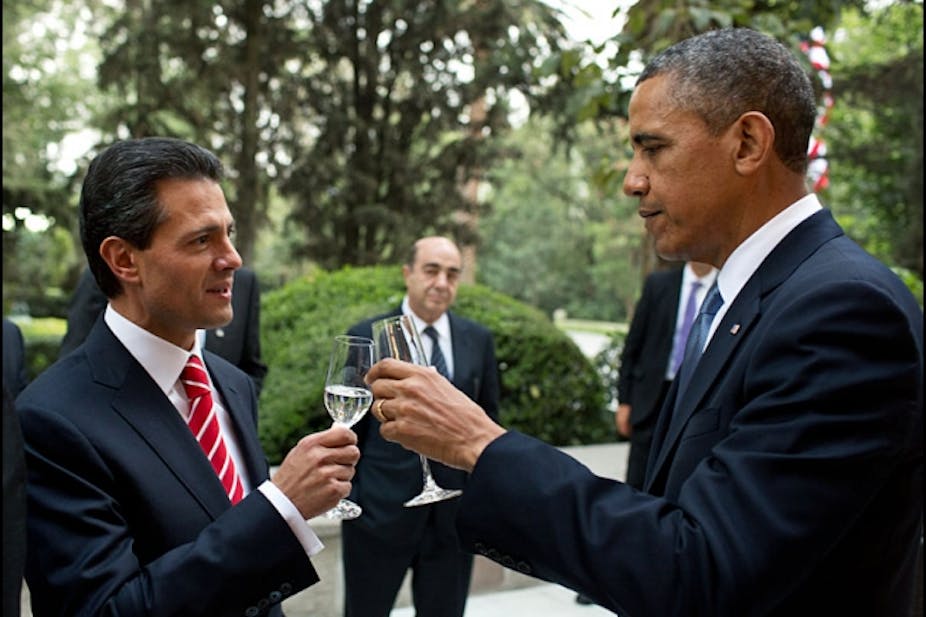Mexico is the latest country to be caught up in the NSA leaks story. It seems the agency had access to president Enrique Peña Nieto’s email account while he was running for office last year. The disclosure offers us a remarkable, if unsurprising, window on how the US government treats its close political allies.
Mexico’s president reacted with contrived indignation and an acceptance of Barack Obama’s assurance that there will be an investigation into the matter. Peña Nieto’s tepid response to the hacking of his emails by the NSA is of little wonder; a perfunctory duty of high-level Mexican politicians is to publicly denounce the infractions of US imperialism while doing nothing concrete to oppose it, lest it upset the close political alliance with Washington.
The Mexico/US partnership goes far beyond political and economic co-operation, however. Spying on the Mexican citizenry has been mutually consensual since World War II.
La CIA
Following the war, at the behest of the US, Mexico established its own internal spying operation. The new secret police, known as the DFS, was modelled on its sister agencies, the FBI and the CIA. It was charged with spying on trade unionists, left-wing political opposition groups, journalists, dissident intellectuals, guerrilla organisations and social movements.
The DFS worked closely with the CIA, which had its biggest Latin America operation in Mexico City. During the heightened paranoia of the Cold War, one of the DFS’s principal functions was to spy on and eradicate popular social movements, whom the government labelled as “subversives”, “anti-Mexicans”, “terrorists” and “Marxists”.
By the 1970s and 1980s the DFS was spying on and eliminating political undesirables at a ferocious rate. But it had also become heavily involved in narcotrafficking and organised crime. The impunity afforded to the agency by the Mexican and US governments meant that, so long as the agency was spying on and eliminating subversives, all manner of other criminal behaviour was tolerated, despite the supposed commitment to fighting the “war on drugs”.
According to famous CIA whistleblower Philip Agee, the spying network and relationship between the DFS and CIA was such that even Mexican presidents (such as Gustavo Díaz Ordaz and Luis Echeverría) acted as informants to the CIA.
Eyes on subversives
A few years ago, I sat at a desk poring over declassified government documents in one of Mexico City’s largest archives. I was looking into how the state spied on dissidents during the 60s and 70s and found that government agencies kept incredibly detailed information on anyone they deemed “subversive”.
Thus I was able to read transcripts of telephone conversations between activists; peruse the floor plans of apartments occupied by Marxists; learn that the state infiltrated political meetings of opposition groups and transcribed their conversations; read the files kept on journalists whose phones had been tapped and whose everyday activity was monitored; and to discover new details on dissidents who had been disappeared.
One question kept bothering me. If this was what they could know about citizens in 1973, how well can they spy on people now?
A recent Mexico-US initiative under the cover of the 2005 Security and Prosperity Partnership (SPP) has allowed for the interception and capturing of information from all kinds of communication systems, including browsing histories, email, online chats, voicemail and phone tapping.
Both governments offered the ever-convenient pretexts of narcotrafficking and terrorism as rationale for the increased militarisation and spying capabilities that the SPP proposed.
By 2009, a more comprehensive bilateral strategy to replace the SPP, known as the Mérida Initiative, was signed by Obama and then-president Felipe Calderón. This promised nonstop US military funding for the foreseeable future.
Increased amounts of military hardware and training of Mexican troops aside, the programme also allowed for large-scale spying on Mexicans. The Federal Investigative Agency (AFI) pushed for a programme of total surveillance and increased storage capacities of all types of electronic communication. The state’s spying capacities have therefore increased in the last few years. For example, in 2012, Mexico’s 30 electronic spying and monitoring stations increased to 107.
Global clampdown
The drive to store ever more information about Mexicans is mirrored not only in the United States, but across the globe. States have recognised the vulnerabilities of electronic communication and are exploiting it to clamp down on dissent and to disable popular grassroots opposition movements.
Other vested interests are also at play. Naturally, it was impossible to establish a system of electronic surveillance without the compliance of Mexico’s telecommunications industry. The Peña Nieto government’s push towards increased information storage results from a collaboration with private sector data giants at a cost of US$100m dollars annually. Indeed, the state-private partnership in spying and data collection, much like the outsourcing of defence spending to private military contractors, privileges these same companies with huge profits paid out of tax revenue. In a rather telling irony of our times, taxpayers pay for their own governments to spy on them.
But perhaps this is just the natural response to a climate of increased popular desperation and disillusionment. The state - in Mexico or elsewhere - will attempt to further its ability to spy on and control the population in order to maintain a status quo which no longer makes much secret of favouring elite interests only.
The importance of the hacking of Peña Nieto’s email account by the NSA dwarfs by comparison with the much more important and larger issue of how the US and Mexican governments collaborate to spy on citizens. For Mexicans and Americans, as for an increasing number of the world’s population, Orwell’s 1984 nightmare of universal surveillance of all aspects of what used to be known as private life has become a present reality.

